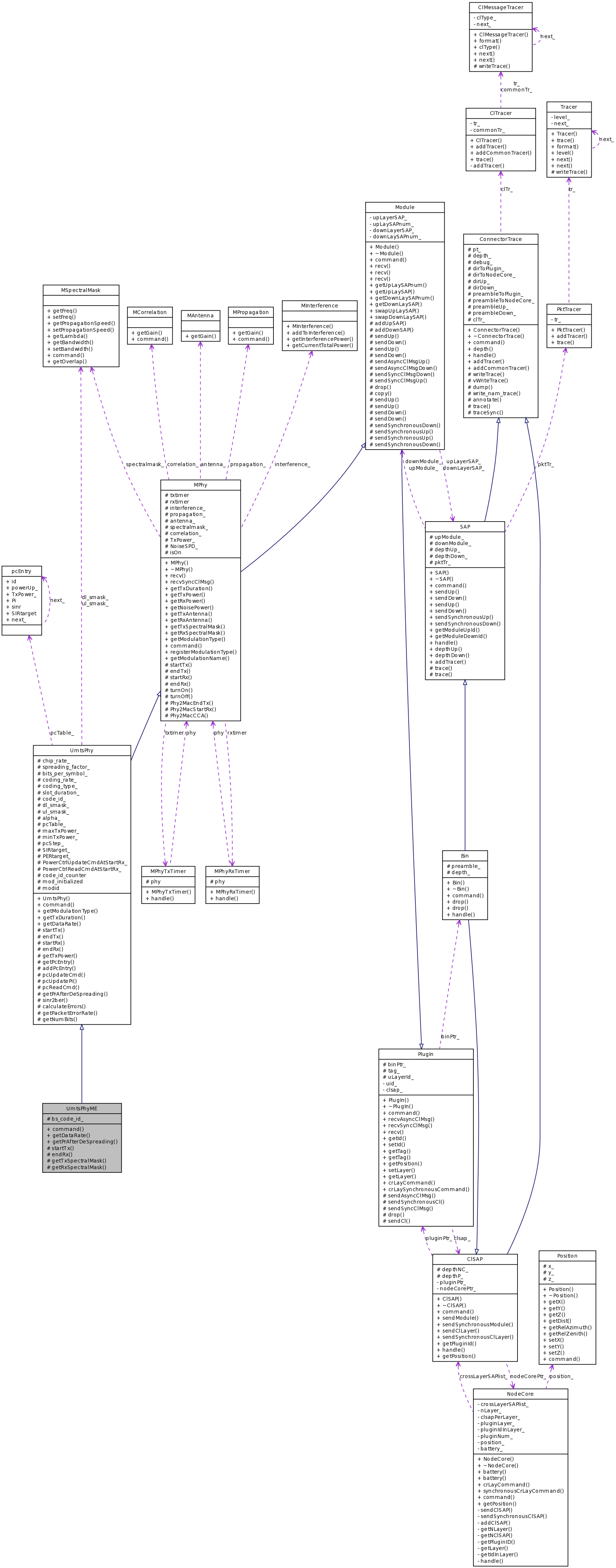


Public Member Functions | |
| int | command (int argc, const char *const *argv) |
| virtual double | getDataRate () |
| double | getPrAfterDeSpreading (Packet *p) |
Protected Member Functions | |
| void | startTx (Packet *p) |
| void | endRx (Packet *p) |
| MSpectralMask * | getTxSpectralMask (Packet *p) |
| MSpectralMask * | getRxSpectralMask (Packet *p) |
Protected Attributes | |
| int | bs_code_id_ |
Definition at line 181 of file umts-phy.h.
| int UmtsPhyME::command | ( | int | argc, | |
| const char *const * | argv | |||
| ) | [virtual] |
TCL command parser
| argc | ||
| argv |
Reimplemented from UmtsPhy.
Definition at line 364 of file umts-phy.cc.
References UmtsPhy::command().
Here is the call graph for this function:

| void UmtsPhyME::startTx | ( | Packet * | p | ) | [protected, virtual] |
Method invoked at the beginning of the transmission of a given packet. This method must be implemented by each class inheriting from the MPhy class. It should be used to set specific header fields of the particular PHY technology being implemented, such as the ModulationType in the MPhy packet header. Furthermore, each implementation of this method must take care of calling sendDown(p)
| p | the given packet |
Reimplemented from UmtsPhy.
Definition at line 434 of file umts-phy.cc.
References hdr_umtsphy::bs_code_id, bs_code_id_, UmtsPhy::code_id_, hdr_umtsphy::direction, hdr_umtsphy::me_code_id, and UmtsPhy::startTx().
Here is the call graph for this function:

| void UmtsPhyME::endRx | ( | Packet * | p | ) | [protected, virtual] |
Method invoked at the end of the reception of a given packet. This method must be implemented by each class inheriting from the MPhy class.
Please note that this method is called for ALL incoming transmissions, that is even if the receiver was actually not synchronized on packet p. As a consequence, each implementation of this method should check if the receiver was actually synchronized on packet p.
Furthermore, reception errors should be evaluated within this method, and the appropriate action should be taken. It is left to the implementer to decide whether the packet should be dropped in case of errors, or whether some error flag (e.g., ch->error) should be set instead to let some upper layer (e.g., MAC) drop the packet by itself. The ModulationType is probably to be checked for, since even if SNIR is high it is not likely we can decode a modulation other the ones each Phy implementation was designed to decode.
Finally, each implementation of this method should take care to call sendUp(p) in case the reception of the packet was successful.
| p | the given packet |
Reimplemented from UmtsPhy.
Definition at line 520 of file umts-phy.cc.
References UmtsPhy::code_id_, hdr_umtsphy::direction, UmtsPhy::endRx(), getPrAfterDeSpreading(), hdr_umtsphy::me_code_id, and hdr_MPhy::Pr.
Here is the call graph for this function:

| MSpectralMask* UmtsPhyME::getTxSpectralMask | ( | Packet * | p | ) | [inline, protected, virtual] |
Returns the spectral mask to be used for the transmission of a given packet.
| p | the packet being transmitted |
Reimplemented from MPhy.
Definition at line 195 of file umts-phy.h.
References UmtsPhy::ul_smask_.
| MSpectralMask* UmtsPhyME::getRxSpectralMask | ( | Packet * | p | ) | [inline, protected, virtual] |
Returns the spectral mask to be used for reception
| p | the packet being received |
Reimplemented from MPhy.
Definition at line 196 of file umts-phy.h.
References UmtsPhy::dl_smask_.
 1.5.2
1.5.2